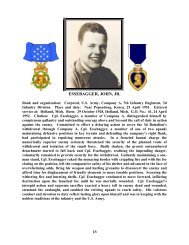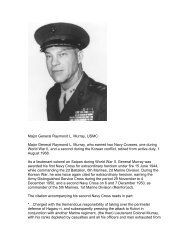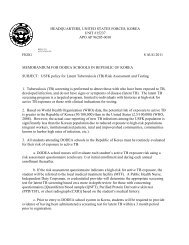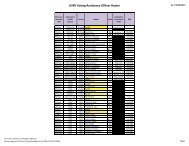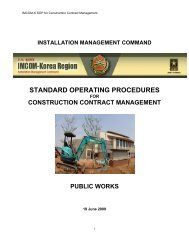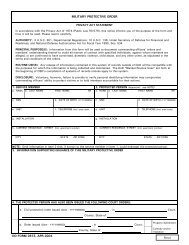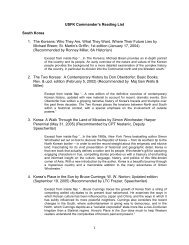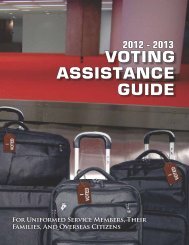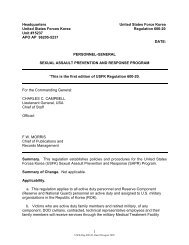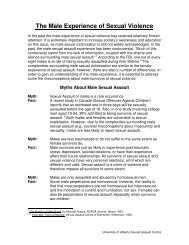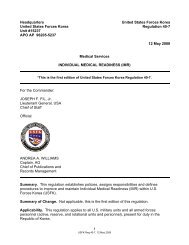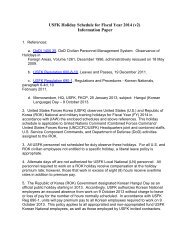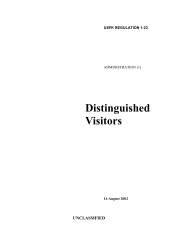Curtis Utz, Assault from the Sea, The Amphibious Landing, Naval ...
Curtis Utz, Assault from the Sea, The Amphibious Landing, Naval ...
Curtis Utz, Assault from the Sea, The Amphibious Landing, Naval ...
Create successful ePaper yourself
Turn your PDF publications into a flip-book with our unique Google optimized e-Paper software.
Republic of China on <strong>the</strong><br />
Security Council, <strong>the</strong>re was<br />
no Soviet veto and <strong>the</strong> council<br />
passed <strong>the</strong> resolution. <strong>The</strong>n,<br />
on <strong>the</strong> 27th, <strong>the</strong> Security<br />
Council approved a second<br />
resolution encouraging UN<br />
members to come to <strong>the</strong> armed<br />
assistance of <strong>the</strong> Republic of<br />
Korea.<br />
Meanwhile, despite earlier<br />
uncertainty over <strong>the</strong> importance<br />
of South Korea to<br />
America’s interests, Truman<br />
decided that U.S. forces<br />
should defend <strong>the</strong> country.<br />
Truman and <strong>the</strong> Joint Chiefs<br />
of Staff (JCS) were concerned<br />
that <strong>the</strong> attack on Korea was<br />
only a diversion for a major<br />
Communist offensive in<br />
Europe. Still, <strong>the</strong>y ordered <strong>the</strong><br />
combat deployment of air<br />
and naval forces in <strong>the</strong> Far<br />
East, including <strong>the</strong> Seventh<br />
Fleet, to <strong>the</strong> Korean <strong>the</strong>ater.<br />
<strong>The</strong> Seventh Fleet was important<br />
not only for <strong>the</strong> help<br />
it could provide to UN forces<br />
fighting in Korea but for its<br />
impact on North Korea’s potential<br />
military allies, <strong>the</strong><br />
People’s Republic of China<br />
and <strong>the</strong> USSR. Fearing that<br />
<strong>the</strong> Communists might mount<br />
a regional offensive, Truman<br />
ordered <strong>the</strong> Seventh Fleet to<br />
“neutralize” <strong>the</strong> Taiwan<br />
Strait and <strong>the</strong>n made that<br />
directive public. Truman<br />
wanted to prevent a Chinese<br />
Communist invasion of Taiwan<br />
as well as an attack on<br />
<strong>the</strong> mainland by Chiang’s<br />
Nationalist forces. After<br />
steaming <strong>from</strong> Subic Bay on<br />
27 June, <strong>the</strong> Seventh Fleet<br />
sent carrier planes flying up<br />
<strong>the</strong> Taiwan Strait as it<br />
passed close to <strong>the</strong> island on<br />
USN416423<br />
Left to right: Royal Navy Captain A. D. Torlesse, Commanding Officer of HMS<br />
Triumph; Rear Admiral John M. Hoskins, Commander Task Force 77; Vice Admiral<br />
Arthur D. Struble, Commander Seventh Fleet; and Rear Admiral William G.<br />
Andrewes, Commander of British Commonwealth Forces, confer on board <strong>the</strong><br />
heavy cruiser Rochester (CA 133), flagship of <strong>the</strong> Seventh Fleet, on 1 July 1950.<br />
As in many o<strong>the</strong>r 20th century conflicts, <strong>the</strong> U.S. and British navies fought side<br />
by side in -Korea.<br />
<strong>the</strong> 29th. Throughout <strong>the</strong><br />
Korean War, Seventh Fleet<br />
forces operated along <strong>the</strong><br />
coast of China, <strong>from</strong> <strong>the</strong> Yellow<br />
<strong>Sea</strong> in <strong>the</strong> north to Hainan<br />
in <strong>the</strong> south, discouraging<br />
<strong>the</strong> Chinese use of <strong>the</strong> sea<br />
and <strong>the</strong> air over it. Beijing<br />
later revealed that it respected<br />
<strong>the</strong> power of <strong>the</strong> fleet’s air,<br />
surface and subsurface forces.<br />
<strong>The</strong> fleet also maintained<br />
naval forces in <strong>the</strong> waters<br />
around <strong>the</strong> Soviet Far East.<br />
Shore-based patrol planes<br />
kept a close watch over Soviet<br />
air and naval bases. U.S.<br />
submarines also prowled<br />
<strong>the</strong> waters off Vladivostok<br />
and <strong>the</strong> straits <strong>from</strong> <strong>the</strong> <strong>Sea</strong><br />
of Japan.<br />
Meanwhile, as units of <strong>the</strong><br />
Seventh Fleet headed for<br />
<strong>the</strong> Yellow <strong>Sea</strong> at <strong>the</strong> end of<br />
June, Admiral Joy’s <strong>Naval</strong><br />
Forces, Japan, dispatched<br />
units to Korea. Early on <strong>the</strong><br />
29th, cruiser Juneau and destroyer<br />
De Haven deployed<br />
off Korea’s east coast to stop<br />
Communist seaborne movement<br />
and to bombard enemy<br />
ground forces advancing down<br />
<strong>the</strong> coastal road. In <strong>the</strong> confusion<br />
during <strong>the</strong> withdrawal<br />
of South Korean forces to<br />
<strong>the</strong> south, Juneau tragically<br />
sank <strong>the</strong> ROKN minelayer<br />
JML 305, which <strong>the</strong> cruiser<br />
took for an enemy ship.<br />
Early in July, Joy sent part<br />
of Struble’s Seventh Fleet<br />
dashing into North Korean<br />
waters to hit <strong>the</strong> enemy’s<br />
central nerve center, <strong>the</strong><br />
capital at Pyongyang. Struble’s<br />
Striking Force (Task Force<br />
77), reinforced by several of<br />
Rear Admiral William G.<br />
Andrewes’s Royal Navy warships,<br />
mustered 24 ships. On<br />
3 and 4 July, only eight days<br />
after <strong>the</strong> North Korean invasion,<br />
planes <strong>from</strong> Valley Forge<br />
and HMS Triumph pounded<br />
<strong>the</strong> air base, rail yards and<br />
bridges near Pyongyang.<br />
In addition to launching<br />
11



